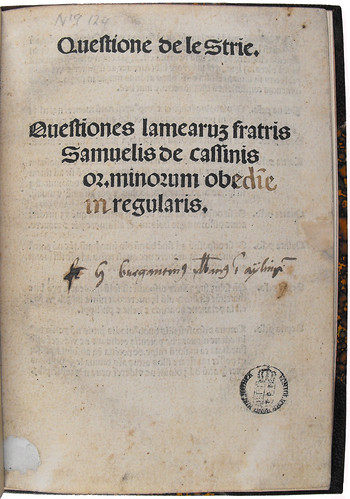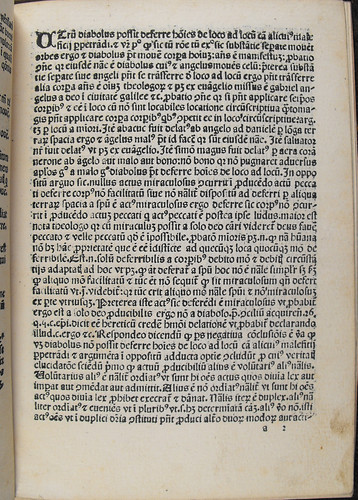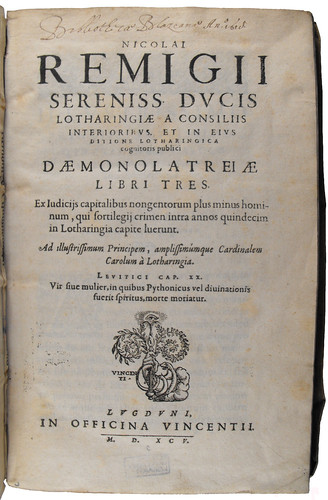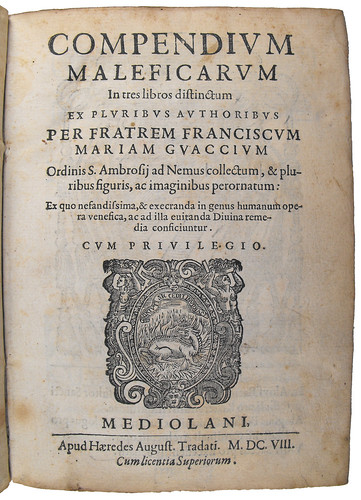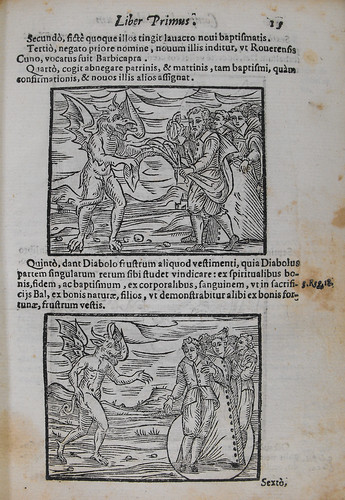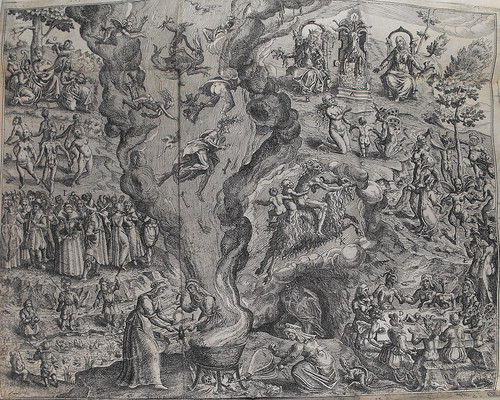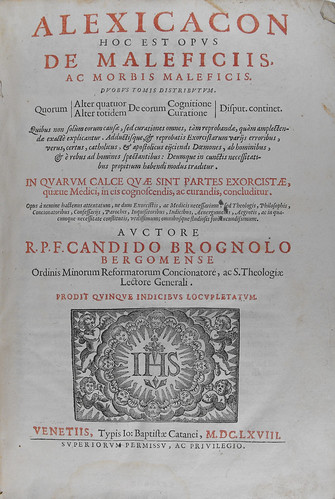Witchcraft and Demonology in: France and Italy
Cassini, Samuele. Questione de le strie.
[Pavia? 1505]; octavo (Sp Coll Ferguson Ag-e.23)
The first book to oppose the identification of witchcraft as a heresy. Cassini attempted to discredit the Inquisitors by arguing that they themselves were guilty of heresy because of their belief in the night flight of witches. He was one of the few writers before the mid-sixteenth century (Symphoriem Champier and Gianfrancesco Ponzinibio were the other two major authors) to oppose the position taken up by the Malleus maleficarum.
A rare book. R.H. Robbins reports only two copies extant, one in Milan and the other in Cornell University Library.
Spina, Bartolommeo, ca, 1475-1546. Quaestio de strigibus, una cum tractatu de praeeminentia sacrae theologiæ, et quadruplici apologia de lamiis contra Ponzinibium.
Romae [i.e. Rome], In Aedibus Populi Romani, 1576; quarto (Sp Coll Ferguson Al-y.62)
These three tracts were first published separately in the 1520s. Spina, an extreme supporter of the belief in witchcraft, opposed Gianfrancesco Ponzinibio, an Italian lawyer who condemned the methods used by the Inquisition to prove the guilt of witches. Sorcery as practised in Italy forms the background to Spina’s book.
Pico della Mirandola, Giovanni Francesco, 1470-1533. Dialogus in tres libros diuisus: tiulus est Strix
[Colophon: ] Bononiae [i.e. Bologna], a Hieronymo de Benedictis, 1523; quarto (Sp Coll Ferguson Al-a.4)
Pico della Mirandola, having had his doubts about witchcraft removed by attending the examinations of those charged with sorcery in Bologna, then proceeded to write this book, so that the matter might better be prosecuted everywhere. The worth of the volume is probably best guaged from Henry Lea’s judgement of Pico della Mirandola: "The credulity of so learned a man is scarce conceivable". This is a copy of the first edition.
Pico della Mirandola was the nephew of the famous humanist of the same time.
Pico della Mirandola, Giovanni Francesco, 1470-1533. Dialogo intitolato La strega, overo di gli inganni de demoni.
Pescia [appresso Lorenzo Torrentino] 1555; quarto (Sp Coll Ferguson Ag-d.33)
The first Italian translation of the Strix, the work of the Dominican Leandro Alberti, was published at Bologna in 1524; it was the first book on witchcraft to be printed in that language.
This is a copy of the second Italian translation, the work of Turino Turini, which appeared at Pescia in 1555.
Olaus, Magnus, Archbishop of Uppsala, 1490-1557. Historia de gentibus septentrionalibus.
Romae [i.e. Rome] [Apud IoannemMairam de Viottis] 1555; folio (Sp Coll Hunterian I.4.4)
Belief in sorcery and demons was firmly implanted in the Scandinavian countries, though persecution of witches never assumed the proportions it did elsewhere.
The Historia de gentibus septentionalibus is divided into twenty-two books, the third of which is called De superstitiosa cultura daemonum populorum aquilonarium. The entire work is profusely illustrated with woodcuts; those in book three show the northern peoples’ special concern with the powers of sorcerers over the sea and ships. Hence, sorcerers were credited with the ability to raise and settle storms, to upset boats, and to cross the sea by means of spells.
Olaus Magnus, the Swedish historian and geographer, was made Archbishop of Upsala in 1544.
Bodin, Jean, 1530-1596. De la demonomanie des sorciers.
Paris, Iacques du Puys, 1580; quarto (Sp Coll Ferguson Al-a.1)
This book was written primarily for the information of judges by one who had himself acted as a judge at many trials in France. It is a landmark in witchcraft literature. Bodin was a particularly avid promoter of the worst features of the witchcraft delusion, following in the tradition of the Malleus Maleficarum. Typical of his extremism is his vigorous support of the torture of suspects.
This copy is of the first edition and contains manuscript notes by the linguist Richard Roberts Jones (1780-1843).
Remy, Nicolas, ca. 1525-1612. Daemonolatreiae libri tres.
Lugduni [i.e. Lyon], In Officina Vincentii, 1595; quarto (Sp Coll Ferguson Al-x.48)
Remy was privy Counsellor to Duke Charles III of Lorraine and became Attorney General of Lorraine in 1591.
This is the first edition of a work which, together with Del Rio’s Disquisitionum magicarum libri sex, largely superceded the Malleus maleficarum. Probably Remy’s work owed much of its influence to the vivid way in which it was written - Remy gave authenticity to his statements by quoting the names of many of those condemned by him and the dates of their trials. On the title page it is claimed that 900 witches had been condemned to death in Lorraine within the fifteen years Remy had acted as judge.
Guazzo, Francesco Maria. Compendium maleficarum.
Mediolani [i.e. Milan], Apud Haeredes August. Tradati, 1608; octavo (Sp Coll Ferguson Ao-a.60, Sp Coll Ferguson Ag-c.50)
Guazzo, a friar in Milan in the early seventeenth century, wrote his Compendium maleficarum at the request of a bishop of Milan. The list of authorities cited in the work totals over 300, ranging from classical authors to his own contemporaries. Despite this apparently weighty scholarship "the whole book is a prodigious collection of marvels ... showing to what incredible lengths human credulity can extend" - Henry C. Lea, Materials toward a history of witchcraft.
The Ferguson Collection contains two copies of the 1608 edition.
Lancre, Pierre de. Tableau de l’inconstance des mauvais anges et demons.
Paris, Nicolas Buon, 1613; quarto (Sp Coll Ferguson Al-x.50)
Pierre de Lancre (1553-1631) sent by Henry IV of France to investigate witchcraft in the Pays de Labourd, a Basque-speaking region in Southwest France, concluded that of the 30,000 inhabitants very few families, including most of the priests, were untouched by sorcery. The Tableau largely stems from his activities in Labourd.
The book contains an engraving of a witches’ sabbat by the Polish engraver Jan Ziarnko. The Tableau, including his engraving, was later satirized by Laurent Bordelon in L’histoire des imaginations ... de Monsieur Oufle, 1710.
Relation de la sortie du demon Balam du corps de la Mere Pnieune des Vrselines de Loudun. Et ses espouuentables mouuements & contorsions en l’exorcisme.
Orleans, Chez Rene Fremont, 1635; quarto (Sp Coll Ferguson Ag-d.22)
The accusations of sorcery brought by the nuns of the Ursuline convent at Loudun against Father Urbain Grandier in 1633 resulted in what is probably the most famous of all witchcraft trials in France. Grandier was found guilty and burnt in 1634.
This incident formed the historical basis for Huxley’s masterly study of mass hysteria, The Devils of Loudun.
Brognolo, Candido, 1607-1677. Alexicacon hoc est opus de maleficiis ac morbis maleficis.
Venetiis [i.e. Venice], Typis Io: Baptistae Catanei, 1668; folio (Sp Coll Ferguson Add. f2)
One result of the belief in demoniacal possession was the publication of numerous volumes on exorcism, of which this work is an important example. These set out to provide detailed instructions and formulae for the recognition of the state of demoniacal possession, for the discovery of a demon’s name, for the cause of possession, and for the expulsion of demons.
Back to see books on Witchcraft and Demonology in German, Switzerland and the Low Countries
Forward to see books on Witchcraft and Demonology in England


